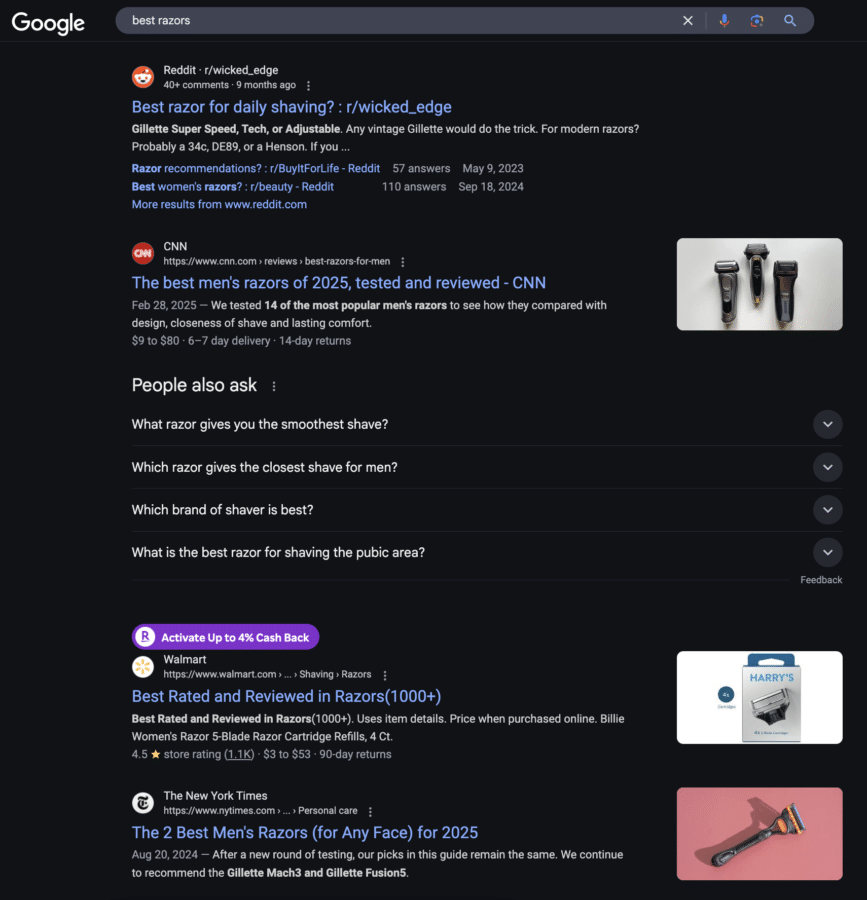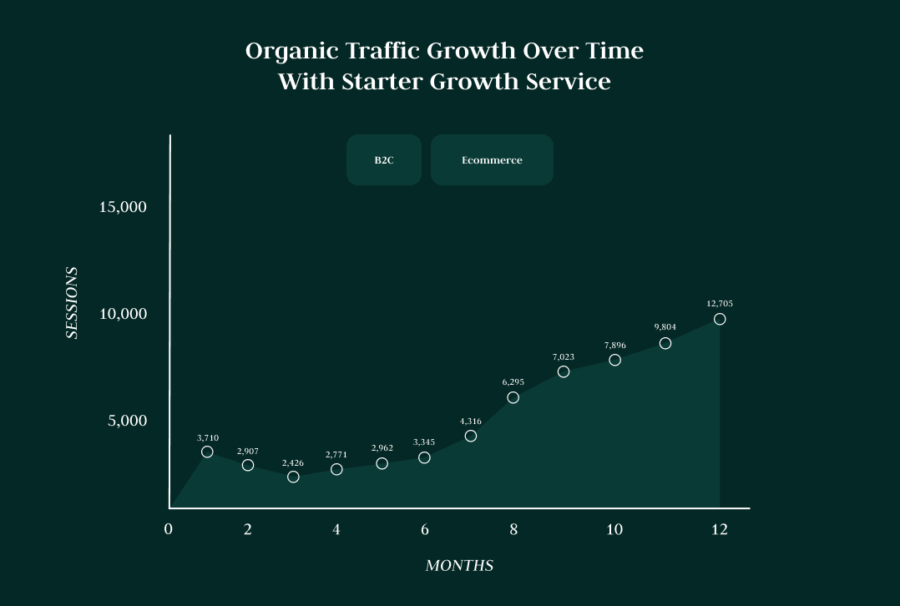Growing a profitable ecommerce brand is hard, especially when you have to rely on costly paid ads to generate sales.
There’s certainly a time and place for pay-per-click ads, but a strong content strategy can transform your website into a machine that drives sales on autopilot.
Today, we’ll share the ecommerce content marketing process we use to turn growing DTC businesses into industry leaders.
We’ll teach you how to:
-
- Identify the topics your customers are interested in
- Set realistic ranking goals that will lead to more sales
- Assess your progress so you can improve your strategy over time
But first, why content marketing?
Why Should Ecommerce Businesses Focus on Content Marketing?
When today’s consumers are thinking about buying something, they go online. In fact, surveys show that 66% of people conduct online research before making a purchase.
Content marketing can help you connect with those customers during their research phase so you can steer them toward your products or services instead of competing businesses.
It can also help you nurture leads, stay connected with existing customers, and increase the public’s awareness of your brand.
We write more about the benefits of content marketing in this article, but here’s a graph that shows how one ecommerce website’s organic traffic improved during their first year working with us. Our content marketing work improved their traffic by 242% in just 12 months!
What Type of Content Works Best for Ecommerce Businesses?
“Content” can be anything from downloadable case studies to podcasts to YouTube Shorts and TikTok videos.
At Intergrowth®, we focus on search-optimized blog content. In other words, we write informative articles that live on our clients’ websites and help to attract organic traffic from search engines.
Most of our content strategies include a mix of these three types of blog articles:
- Awareness Content
- Sales Centric Content
- Thought Leadership Content
Each type of blog article serves a different purpose:
Awareness Content
Awareness Content drives website traffic and brand awareness. These are educational resources that attract a wide audience who are interested in topics related to your product.
Some of those readers might be interested in your products, too.
Sales Centric Content
Sales Centric Content drives more conversions and revenue. Sales Centric Content could be:
- Pages that highlight product features
- Competitor comparisons
- Case studies
- Customer testimonials
- Customer support resources (ex., product tutorials, FAQs, etc.).
Thought Leadership Content
Thought Leadership Content aims to build trust and respect from your industry peers. It might take the form of industry predictions, contrarian opinions, and other insights that reflect years of industry experience.
While this content won’t see much search visibility, it’s more likely to be shared on social media and circulated in private channels (Slack, email, etc.), thus increasing your brand’s credibility.
How Do You Know Which Type of Content to Create?
There’s no clear-cut solution for defining how much of your efforts should go into each content type.
However, we recommend businesses focus most efforts on Awareness Content and Sales Centric Content until they reach several thousand readers per month.
Awareness Content won’t drive many direct sales. However, Awareness Content brings more visibility to your brand and funnels visitors to Sales Centric Content and specific product pages.
Sales Centric Content will have high conversion rates and generate far more sales per website visitor. However, Sales Centric Content tends to see less traffic from search engines.
Why?
- Search queries with a high commercial intent (think “buy red shoes”) will be much more challenging to rank for than most educational search queries (think “types of shoes”)
- Your prospective customers won’t search for topics like “[your business] success stories” until they know about your business.
Our Proven Ecommerce Content Marketing Strategy
Here’s how you can build a content strategy for your ecommerce business:
- Audit yourself and your competition
- Map out short-term vs. long-term ranking goals
- Write the best possible article about each keyword topic
- Review performance and pivot for better results
We’ll briefly run through each of these steps below:
1. Audit Yourself and Your Competition
We have an extensive competitive research process, which we outline here.
At a high level, this step is about understanding how you stack up against your biggest competitors.
It involves asking a few important questions about each competitor’s website (specifically their blog, in this case):
- Which blog articles drive the most traffic to their site? This tells us what type of content the target audience wants to see.
- Which blog articles drive the most qualified traffic? We want to attract visitors that are likely to buy.
- Which blog articles get shared the most online? Backlinks from other websites help to build your site’s credibility, which will make your site appear higher in search engine results.
The fastest way to answer these questions is to use an SEO tool like Ahrefs or SEMRush. These tools will show you which pages perform the best and what keywords people search that lead them to those pages.
The goal here is to identify the topics that your competitors have created content about.
Then, you have to ask the most important question:
Can you write a better article about those topics?
Create a list of the keywords that you know you can write more in-depth, informative articles about. Those are the basis of your content strategy.
2. Map Out Short-Term vs. Long-Term Ranking Goals
You won’t be able to rank for all of your target keywords right away.
For instance, let’s say that “pet food” is one of your target keywords. You won’t likely rank for that in the near future because industry giants like Chewy and Petco have put a lot of resources into solidifying their place at the top of Google.
However, you could rank for terms with less competition like “how to keep a dog healthy.” This keyword has far less competition but could still help you attract new readers and advertise your products.
So, it’s important to target some of those low-competition keywords early on in your content marketing journey. You should still build out pages around those high-competition keywords like “pet food” but don’t plan to rank for them until your site earns some credibility.
We dive deeper into assessing short-term vs. long-term ranking goals here.
A few things to keep in mind while assessing your goals:
- Engagement play a big role in keyword rankings: Google wants to see that people are not only clicking your link but staying on your site, scrolling, and sharing the article via links and social shares.
- Ahrefs and SEMRush are valuable for research: They’ll tell you roughly how many backlinks you’ll need to outrank your competitor.
- Don’t buy backlinks: It’s against Google’s policies; invest in a link-building service or use these above-board tactics instead.
- Not every keyword needs a blog article: Your main keywords (e.g., “pet food” should be the target keyword for your homepage, not a blog. Target more niche terms with your blog articles.
3. Write the best possible article about each keyword topic
No matter what keyword you’re trying to rank for, there’s going to be a lot of competition.
(Sometimes a lot of competition).
Keyword optimization alone won’t help you outrank those other articles. In order to get people clicking and engaging with your page (which helps to sustain rankings), you need to provide something your competitors don’t.
Before you start writing, think hard about what you can bring to this topic that isn’t already available online. Maybe it’s some unique data or a related anecdote. Differentiating your article will help you show Google that your content isn’t just a reworded version of the existing search results.
4. Review Performance and Pivot for Better Results
Step four is to assess your performance. I recommend using Google Analytics to track traffic and conversions and Ahrefs or SEMRush to track keyword rankings.
We manage all tracking and measurement for our clients and report our results during a monthly consultation call.
More on what our monthly consultation calls look like here:
Here are some of the questions we ask ourselves that you can steal to run your own analysis:
- What’s the primary goal of each piece of content you created? What metrics can we monitor to track our performance? Which pieces of content are performing best?
- Do you see trends in content formats (videos, blog articles, infographics, podcasts, quizzes, etc.) that better achieve their goals?
- How did your ecommerce store perform over the past month compared to the previous month? Compared to the same month last year? Which pages improved in performance? Which pages declined in performance?
- How are you trending for your highest-priority keyword rankings? We track all keyword rankings daily. You can do the same in most keyword research tools (our recommendation is to use SEMRush or Ahrefs)
Based on this analysis, tweak your content strategy to cut back on initiatives that aren’t performing as expected and double down on initiatives that are driving results.
Common Ecommerce Content Marketing Mistakes to Avoid
1. Focusing Too Heavily on On-Page SEO
We see many emerging ecommerce brands invest heavily in on-page SEO (initiatives like optimizing title tags, URL structures, header tags, etc.).
These initiatives help search engines understand what your website is about and can have a massive impact on search performance. However, they don’t give your site any more credibility.
Think of it this way:
Investing heavily in on-page SEO for a brand-new website is the equivalent of sitting in your car with an empty tank of gas while you plan out the whole route for your cross-country road trip.
Sure, it’ll come in handy to know where you’re going. But you could also fill your tank, start driving in the general direction of your destination, and figure out the exact directions as you start the trip.
Here are the only items you should be thinking about outside of content and links until you reach that point.
2. Targeting “Best” Terms on Product Pages
We often see ecommerce brands chasing unrealistic ranking goals. The classic example is targeting search themes like “best [product]”.
While ranking at the top of a search like “best razors” is a great way to drive sales, these rankings are unfortunately rare.
Why? Search intent.
Google knows that the people who search “best razors” are likely seeking an unbiased list of brands and reviews. Ten of the top ten results on the first page of Google are product reviews featuring a dozen different razor brands from an unbiased third party.

We see the best results when we optimize product pages around niche variants of those product-related queries that relate to your unique solution.
For example, a razor blade company may target “high-end razor blades for dry skin”.
Niche variant optimizations allow brands to drive qualified traffic to their product pages faster as content marketing expands their ranking potential even further.
3. Not Investing in Other Facets of Digital Marketing
We’ll occasionally talk to businesses that only invest their marketing dollars in content marketing.
Content marketing is a phenomenal long-term investment for ecommerce. However, content marketing should be one part of your marketing plan.
Every marketing channel has its pros and cons. Here are a few other marketing investments to consider pairing with your content marketing efforts:
- Email marketing and SMS marketing are the perfect tools to pair with content creation. Content drives initial customers. Email/SMS allows you to sell to those customers regularly.
- PPC (think Google Ads, Facebook Ads, etc.) is an expensive way to acquire each customer. However, this is an excellent investment for increasing your customers while you gain traction with your SEO efforts (more on the SEO vs. PPC debate here).
- Social media marketing is a great brand-building tool. Dozens of DTC brands/business owners have turned themselves into industry influencers and used social media to build a loyal customer following.
P.S. Online marketing is changing rapidly in the midst of AI. Here’s how brands will win at online marketing in this AI era.
4. Giving up on Content Marketing Too Early
Content marketing and SEO are long-term investments that drive exponential revenue growth.
One of the biggest mistakes we see ecommerce companies make is investing in content creation for three months, not seeing a noticeable increase in sales, and deciding to scrap future content initiatives.
So what should you expect for content marketing results?
The guidance we give clients is to expect minimal growth in months 1-3, gradual growth in months 4-6, and exponential growth in months 7 and beyond.

For example, here’s a look at one ecommerce client’s growth over the first 12 months of the relationship from our content marketing services.
Months 1-3 were flat. We used this time to build our content marketing strategy, publish our first handful of articles, and implement our SEO foundation.
Months 4-6 yielded gradual growth. We started to see more substantial growth in month seven.
By month 12, organic traffic is now up 535.1% (and revenue from organic traffic is up 80.8%).
Read more: The Benefits of SEO for Ecommerce Benefits
Content marketing is one of the best investments ecommerce brands can make in their business.
Identify topics your customers seek out information about, write informative guides about those topics, include relevant links to your product and category pages, and encourage other businesses in your industry to link to your website.
It’s the least sexy marketing initiative you can focus on. However, it works time and time again.
If you want to take the do-it-yourself approach, download our full guide to building your own content marketing machine.
Prefer to work with experts who do this every day? Let’s hop on a consultation call to discuss your goals and build the perfect action plan for your business.
SCALE YOUR ORGANIC TRAFFIC
Subscribe to our monthly newsletter






